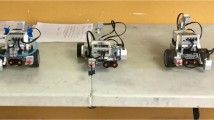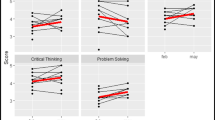Abstract
This paper presents an integrative standards-based STEM curriculum that uses robots to develop students’ computational thinking. The need for the project is rooted in both the overall lack of existing materials as well as the need for materials that directly address specific STEM standards in an integrative fashion. The paper details the first mesocycle of an educational design research project (EDR) in which a robust theoretical framework was created to support the development of a 2-week series of robotics lessons. Analysis of evaluation data from 5 fifth-grade teachers and their students revealed that the integrative curriculum supported student problem solving and teacher practices that supported cognitive demand. Implications for research, design, and instruction are discussed.
Similar content being viewed by others
References
Alibali, M., & Nathan, M. (2011). Embodiment in mathematics teaching and learning: evidence from learners’ and teachers’ gestures. The Journal of the Learning Sciences, 21(2), 247–286. doi:10.1080/10508406.2011.611446.
Barr, D., Harrison, J., & Conery, L. (2011). Computational thinking: a digital age skill for everyone. Learning & Leading with Technology, 38(6), 20–23.
Baxter, P., & Jack, S. (2008). Qualitative case study methodology: study design and implementation for novice researchers. The Qualitative Report, 13(4), 544–559.
Bers, M. (2010). The TangibleK robotics program: Applied computational thinking for young children. Early Childhood Research and Practice, 12(2), 1–20.
Boncoddo, R., Dixon, J. A., & Kelley, E. (2010). The emergence of a novel representation from action: evidence from preschoolers. Developmental Science, 13(2), 370–377. doi:10.1111/j.1467-7687.2009.00905.x.
Boston, M. D., & Smith, M. S. (2009). Transforming secondary mathematics teaching: increasing the cognitive demands of instructional tasks used in teachers’ classrooms. Journal for Research in Mathematics Education, 40, 119–156.
Brown, R., Brown, J., Reardon, K., & Merrill, C. (2011). Understanding STEM: current perceptions. Technology and Engineering Teacher, 70(6), 5–9.
Capraro, R. M., & Han, S. (2014). STEM: the education frontier to meet 21st century challenges. Middle Grades Research Journal, 9(3), xv–xv.
Capraro, R. M., Capraro, M. M., & Morgan, J. R. (2013). STEM project-based learning. Rotterdam: SensePublishers: 10(1007), 978–94.
Chang, C. W., Lee, J. H., Chao, P. Y., Wang, C. Y., & Chen, G. D. (2010). Exploring the possibility of using humanoid robots as instructional tools for teaching a second language in primary school. Educational Technology & Society, 13(2), 13–24.
Daily, S., Leonard, A., Jorg, S., Babu, S., Gunderson, K., & Parmar, D. (2015). Embodying computational thinking: initial design of an emerging technological tool. Technology, Knowledge and Learning, 20, 79–84. doi:10.1007/s10758-014-9237-1.
Dick, J., Dildine, J. P., Reese, G. C., Smith, K., Storaasli, M., Travers, K. J., Wotal, S., & Zygas, D. (2005). Engaging students in authentic mathematics activities through calculators and small robots. In W. J. Masalski (Ed.), Technology-supported mathematics learning environments NCTM sixty-seventh yearbook (pp. 318–328). Reston: National Council of Teachers of Mathematics.
Furner, J. M., & Kumar, D. D. (2007). The mathematics and science integration argument: a stand for teacher education. Eurasia Journal of Mathematics, Science & Technology Education, 3(3), 185–189.
Gonzalez, H. B., & Kuenzi, J. J. (2012). Science, technology, engineering, and mathematics (STEM) education: a primer. Congressional Research Service, Library of Congress.
Grover, S., & Pea, R. (2013). Computational thinking in K-12: a review of the state of the field.
Han, I. (2013). Embodiment: a new perspective for evaluating physicality in learning. Journal of Educational Computing Research, 49(1), 41–59. doi:10.2190/EC.49.1.b.
Hmelo-Silver, C. E., Duncan, R. G., & Chinn, C. A. (2007). Scaffolding and achievement in problem-based and inquiry learning: a response to Kirschner, Sweller, and Clark (2006). Educational Psychologist, 42(2), 99–107.
Honey, M., Pearson, G., & Schweingruber, H. (2014). STEM integration in K-12 education: status, prospects, and an agenda for research. Rockville: Committee on Integrated STEM Education: National Research Council.
Johnson, L., Adams Becker, S., Estrada, V., & Freeman, A. (2015). NMC horizon report: 2015 K-12 edition. Austin: The New Media Consortium.
Kapur, M. (2008). Productive failure. Cognition and Instruction, 26(3), 379–424. doi:10.1080/07370000802212669.
Kapur, M., & Bielaczyc, K. (2011). Classroom-based experiments in productive failure. In Proceedings of the 33rd annual conference of the Cognitive Science Society (pp. 2812–2817). Austin: Cognitive Science Society.
Karim, M. E., Lemaignan, S., & Mondada, F. (2015). A review: can robots reshape K-12 STEM education? In Advanced robotics and its social impacts (ARSO), 2015 I.E. International Workshop on (pp. 1–8). IEEE.
Kazakoff, E. R., Sullivan, A., & Bers, M. U. (2013). The effect of a classroom-based intensive robotics and programming workshop on sequencing ability in early childhood. Early Childhood Education Journal, 41(4), 245–255.
Kennedy, J., Baxter, P., & Belpaeme, T. (2014). Comparing robot embodiments in a guided discovery learning interaction with children. International Journal of Social Robotics, 7, 293–308. doi:10.1007/s12369-014-0277-4.
Kennedy, T., & Odell, M. (2014). Engaging students in STEM education. Science Education International, 25(3), 246–258.
Khanlari, A. (2016). Teachers’ perceptions of the benefits and the challenges of integrating educational robots into primary/elementary curricula. European Journal of Engineering Education, 41(3), 320–330.
Lanzonder, A. (2005). Do two heads search better than one? Effects of student collaboration on web search behaviour and search outcomes. British Journal of Educational Technology, 36(3), 465–475.
Levenson, E., Tsamir, P., & Tirosh, D. (2010). Mathematically based and practically based explanations in the elementary school: teachers’ preferences. Journal of Mathematics Teacher Education, 13(4), 345–369.
Lin, T., & Anderson, R. (2008). Reflections on collaborative discourse, argumentation, and learning. Contemporary Educational Psychology, 33, 443–448. doi:10.1016/j.cedpsych.2008.06.002.
Ma, L. (1999). Knowing and teaching elementary mathematics: teachers’ understanding of fundamental mathematics in China and the United States. Mahwah: Lawrence Erlbaum Associates.
Manlove, S., Lazonder, A. W., & de Jong, T. (2006). Regulative support for collaborative scientific inquiry learning. Journal of Computer Assisted Learning, 22, 87–98. doi:10.1111/j.1365-2729.2006.00162.x.
Metz, S. S. (2007). Attracting the engineers of 2020 today. In R. Burke & M. Mattis (Eds.), Women and minorities in science, technology, engineering and mathematics: upping the numbers (pp. 184–209). Northampton: Edward Elgar Publishing.
McGill, M. M. (2012). Learning to program with personal robots: influences on student motivation. ACM Transactions on Computing Education, 12(1), 4:1–4:32.
McKenney, S. E., & Reeves, T. C. (2012). Conducting educational research design: what, why and how. Oxford: Taylor & Francis.
Meyrick, K. M. (2012). How STEM education improves student learning. Meridian, 14(1).
Morrison, J., French, B., & McDuffie, A. (2015). Identifying key components of teaching and learning in a STEM school. School Science and Mathematics, 115(5), 244–255. doi:10.1111/ssm.12126.
National Academies. (2007). Rising above the gathering storm: energizing and employing America for a brighter economic future. Washington: National Academies Press.
National Research Council (US). Committee on Highly Successful Schools or Programs for K-12 STEM Education. (2011). Successful K-12 STEM education: identifying effective approaches in science, technology, engineering, and mathematics. Washington: National Academies Press.
Nussbaum, E. M. (2008). Collaborative discourse, argumentation, and learning: preface and literature review. Contemporary Educational Psychology, 33(3), 345–359.
Pea, R. (1987). Cognitive technologies for mathematics education. In A. Schoenfled (Ed.), Cognitive science and mathematics education (pp. 89–122). Hillsdale: Erlbaum.
Perlman, R. (1976). Using computer technology to provide a creative learning environment for preschool children (report no. LOGO-24). Washington: National Science Foundation.
Saldaña, J. (2015). The coding manual for qualitative researchers. Los Angeles: Sage.
Sengupta, P., Kinnebrew, J., Basu, S., Biswas, G., & Clark, D. (2013). Integrating computational thinking with K-12 science education using agent-based computation: a theoretical framework. Education and Information Technologies, 18, 351–380. doi:10.1007/s10639-012-9240-x.
Stein, M. K., Smith, M. S., Henningsen, M., & Silver, E. A. (2000). Implementing standards-based mathematics instruction: a casebook for professional development. New York: Teachers College Press.
Stohlmann, M., Moore, T. J., & Roehrig, G. H. (2012). Considerations for teaching integrated STEM education. Journal of Pre-College Engineering Education Research (J-PEER), 2(1), 4. doi:10.5703/1288284314653.
Stoltz, S. (2015). Embodied learning. Educational Philosophy and Theory: Incorporating ACCESS, 47(5), 474–487. doi:10.1080/00131857.2013.879694.
Sung, W., Ahn, J., Kai, S. M., & Black, J. B. (2017). Effective planning strategy in robotics education: an embodied approach. In Society for Information Technology & Teacher Education International Conference (pp. 1065–1071). Association for the Advancement of Computing in Education (AACE).
Tawfik, A. A., Rong, H., & Choi, I. (2015). Failing to learn: towards a unified design approach for failure-based learning. Educational Technology Research and Development, 63(6), 975–994. doi:10.1007/s11423-015-9399-0.
Tekkumru-Kisa, M., Stein, M. K., & Schunn, C. (2015). A framework for analyzing cognitive demand and content-practices integration: task analysis guide in science. Journal of Research in Science Teaching, 52(5), 659–685.
Wang, H. H., Moore, T. J., Roehrig, G. H., & Park, M. S. (2011). STEM integration: teacher perceptions and practice. Journal of Pre-College Engineering Education Research (J-PEER), 1(2), 2.
Wilensky, U., Brady, C. E., & Horn, M. S. (2014). Fostering computational literacy in science classrooms. Communications of the ACM, 57(8), 24–28.
Wing, J. M. (2006). Computational thinking. Communications of the ACM, 49(3), 33–35.
Witney, D., & Smallbone, T. (2011). Wild work: can using wilds enhance student collaboration for group assignment tasks? Innovations in Education and Teaching International, 48(1), 101–110. doi:10.1080/14703297.2010.54376.
Author information
Authors and Affiliations
Corresponding author
Ethics declarations
Conflict of Interest
The work described in this paper was funded in part through Roborobo, Inc., a private company in South Korea. Funding helped support researcher and graduate assistant salaries during the development, implementation, and data collection associated with the curriculum. However, the funding agency had no influence on the collection, analysis, or interpretation of the data. The local school partners involved with this research did not receive any financial benefit from Roborobo Inc.
Additional information
This research was conducted as part of the Research for the Advancement of Innovative Learning (http://rail.coe.uga.edu)
Rights and permissions
About this article
Cite this article
Kopcha, T.J., McGregor, J., Shin, S. et al. Developing an Integrative STEM Curriculum for Robotics Education Through Educational Design Research. J Form Des Learn 1, 31–44 (2017). https://doi.org/10.1007/s41686-017-0005-1
Published:
Issue Date:
DOI: https://doi.org/10.1007/s41686-017-0005-1




